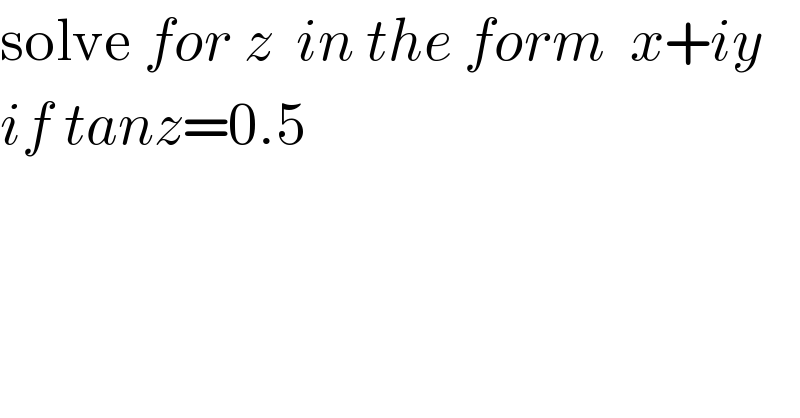
Question and Answers Forum
Question Number 50849 by peter frank last updated on 21/Dec/18

Answered by ajfour last updated on 21/Dec/18
![e^(iz) = cos z+isin z e^(−iz) = cos z−isin z tan z= ((e^(iz) −e^(−iz) )/(i(e^(iz) +e^(−iz) ))) let e^(iz) = e^(−y+ix) = e^(−y) (cos x+isin x) ⇒ e^(−iz) = e^(y−ix) = e^y (cos x−isin x) ⇒ tan z = (((e^(−y) −e^y )cos x+i(e^(−y) +e^y )sin x)/(i[(e^(−y) +e^y )cos x+i(e^(−y) −e^y )sin x])) let e^(−y) +e^y = u , e^(−y) −e^y = v tan z = (((−ivcos x+usin x)(ucos x−ivsin x))/(u^2 cos^2 x+v^2 sin^2 x)) tan z = ((−iuv+(u^2 −v^2 )sin 2x)/(2(u^2 cos^2 x+v^2 sin^2 x))) if tan z = (1/2) , ⇒ uv = 0 or e^(−2y) =e^(2y) ⇒ y = 0 ⇒ u = 2 , v = 0 (((u^2 −v^2 )sin 2x)/(2(u^2 cos^2 x+v^2 sin^2 x))) = (1/2) ⇒ tan x = (1/2) ⇒ z = x = tan^(−1) (1/2)+nπ .](Q50857.png)
Commented by peter frank last updated on 21/Dec/18
![ans [ z=((πn)/2)+26.56+0.00000119i]](Q50860.png)
Commented by MJS last updated on 21/Dec/18

Commented by peter frank last updated on 22/Dec/18

Answered by MJS last updated on 21/Dec/18

Answered by peter frank last updated on 21/Dec/18

